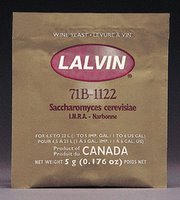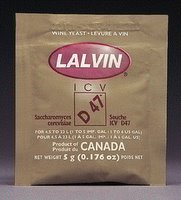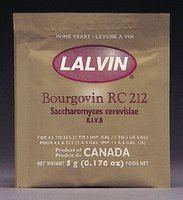Lavlin Yeast Descriptions
Tuesday, November 15, 2005
I have used this line of yeast with a lot of success and it is my preferred yeast. It seems to make a smoother and better tasting wine. The yeast costs a little more than the Red Star, but I think it is worth it. If you get a chance, check out the Lavlin Yeast web site. Some really interesting reading about the types and number of products that are available. I copied this information off their site so that it would be an easy to use reference.
The 71B strain is a rapid starter with a constant and complete fermentation between 15° and 30°C (59° and 86°F) that has the ability to metabolize high amounts (20% to 40%) of malic acid. In addition to producing rounder, smoother, more aromatic wines that tend to mature quickly, it does not extract a great deal of phenols from the must so the maturation time is further decreased.
The 71B is used primarily by professional winemakers for young wines such as vin nouveau and has been found to be very suitable for blush and residual sugar whites. For grapes in regions naturally high in acid, the partial metabolism of malic acid helps soften the wine. The 71B also has the ability to produce significant esters and higher alcohol, making it an excellent choice for fermenting concentrates.
Selected by the Institut Coopératif du Vin (ICV) in Montpellier among numerous killer strains isolated and studied by Pierre Barre at INRA, the K1V-1116 strain was the first competitive factor yeast to go into commercial production and has become one of the most widely used active dried wine yeasts in the world.
The K1V-1116 strain is a rapid starter with a constant and complete fermentation between 15° and 30°C (59° and 86°F), capable of surviving a number of difficult conditions, such as low nutrient musts and high levels of SO2 or sugar. Wines fermented with the K1V-1116 have very low volatile acidity, H2S and foam production.
The K1V-1116 strain tends to express freshness of white grape varieties such as Sauvignon Blanc, Chenin Blanc and Seyval. The natural fresh fruit aromas are retained longer than with other standard yeast strains. Fruit wines and wines made from concentrates poor in nutrient balance benefit from the capacity of K1V-1116 to adapt to difficult fermentation conditions. Restarts stuck fermentations 
This strain was isolated from grapes grown in the Côte de Rhône region of France by Dr. Dominique Delteil, head of the Microbiology Department, Institut Coopératif du Vin (ICV), in Montpellier. ICV D-47 strain was selected from 450 isolates collected between 1986 and 1990.
The ICV D-47 is a low-foaming quick fermenter that settles well, forming a compact lees at the end of fermentation. This strain tolerates fermentation temperatures ranging from 10° to 30°C (50° to 86°F) and enhances mouthfeel due to complex carbohydrates. Malolactic fermentation proceeds well in wine made with ICV D-47.
This strain is recommended for making wines from white varieties such as Chardonnay and Rosé. It is also an excellent choice for producing mead, however be sure to supplement with yeast nutrients, especially usable nitrogen
The EC-1118 strain was isolated, studied and selected from Champagne fermentations. Due to its competitive factor and ability to ferment equally well over a wide temperature range, the EC-1118 is one of the most widely used yeasts in the world.The fermentation characteristics of the EC-1118 - extremely low production of foam, volatile acid and H2S - make this strain an excellent choice.
This strain ferments well over a very wide temperature range, from 7° to 35°C (45° to 95°F) and demonstrates high osmotic and alcohol tolerance. Good flocculation with compact lees and a relatively neutral flavor and aroma contribution are also properties of the EC-1118.
The Bourgovin RC 212 strain was selected from fermentations produced in the Burgundy region by the Bureau interprofessionnel des vins de Bourgogne (BIVB). It was selected for its ability to ferment a traditional heavier-style Burgundian Pinot Noir.
The RC 212 is a low-foaming moderate-speed fermenter with an optimum fermentation temperature ranging from 15° to 30°C (59° to 86°F). A very low producer of hydrogen sulfide (H2S) and sulphur dioxide (SO2), the RC 212 shows good alcohol tolerance from 12% to 14% per volume.
The RC 212 is recommended for red varieties where full extraction is desired. Lighter red varieties also benefit from the improved extraction while color stability is maintained throughout fermentation and aging. Aromas of ripe berry and fruit are emphasized while respecting pepper and spicy notes.

 Follow Me On Twitter
Follow Me On Twitter

2 comments:
I enjoyed reading some of your posts Blogger. I was looking for wine refrigerator related information and found your site. I have a wine refrigerator site. You'll find everything about wine, gift baskets, Napa Valley wine tours, and how to keep your wine properly chilled until it's ready to drink. Come and check it out if you get time :-)
Hi Blogger. I was looking for wine cooling system related information and came across your site. Very good reading! I have a wine cooling system site. You'll find everything about wine, gift baskets, Napa Valley wine tours, and how to keep your wine properly chilled until it's ready to drink. Check it out when you can :)
Post a Comment